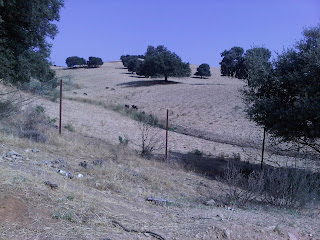Assuming vineyards would be visible on all sides when approaching the perfectly preserved small town on its vertiginous crag, our first disillusionment came thanks to the new road which actually descends into a plain strewn with light industry and social housing.
 No vineyards to be seen anywhere and just the back end of Ronda of which we had been previously blissfully unaware.
No vineyards to be seen anywhere and just the back end of Ronda of which we had been previously blissfully unaware.Ploughing through the town (much larger than suspected) we finally came on the Centro Ciudad and missed any Bodegas and the local branch of the Museo del Vino we somehow expected would be on hand, soon finding ourselves going out the other side. Still optimistic, we pressed on through nothing but olive groves on side roads and the small road signposted 'Algeciras'. Time was against us by now so we stopped at a 'Mirador' and surveyed the horizon without success. There was a small patch of lighter green near the ring road from which we had come so we drove towards tha,t again without success.
So finally we had to ask at a roadside bar. The caballero looked mystified but then suggested we took the road for Sevilla and turn off after a few Km. towards Ronda Vieja.
 And so it was that we finally found our Vinedas de Ronda, discretely tucked away, almost apologetically among the olive groves and various other farming enterprises.
And so it was that we finally found our Vinedas de Ronda, discretely tucked away, almost apologetically among the olive groves and various other farming enterprises.Decidedly vine-growing in Ronda is still in its infancy.
 Our favourite producer, Schatz was the first property we came upon.
Our favourite producer, Schatz was the first property we came upon. It was so much smaller than we imagined and there was no sign of life, let alone a Cellar Door shop or a Reception Area. Herr Schatz is a Swabian who set up here some years ago and brought Lemberger vines with him, hence his popularity in our pages. He must have been looking for somewhere pretty wild and isolated;
It was so much smaller than we imagined and there was no sign of life, let alone a Cellar Door shop or a Reception Area. Herr Schatz is a Swabian who set up here some years ago and brought Lemberger vines with him, hence his popularity in our pages. He must have been looking for somewhere pretty wild and isolated; the contrast with German wine villages where the vineyards are part of the town couldn't be more stark.
the contrast with German wine villages where the vineyards are part of the town couldn't be more stark.  Huge birds (Buzzards?) wheeled overhead and masses of other rather exotic tiny ones seemed to spring up on our approach. They can't be a pest in the vineyard because we didn't see any netting.
Huge birds (Buzzards?) wheeled overhead and masses of other rather exotic tiny ones seemed to spring up on our approach. They can't be a pest in the vineyard because we didn't see any netting. The vineyard itself is immaculately kept and large solar panels lead one to believe the Ecological tag must be serious.
The vineyard itself is immaculately kept and large solar panels lead one to believe the Ecological tag must be serious.  There was one other vineyard signposted at the Ronda Vieja turn-off: Dona Feliza 'Chinchilla'. Finding this was no easy matter as we careered down the wrong road clearly signposted as far as we were concerned
There was one other vineyard signposted at the Ronda Vieja turn-off: Dona Feliza 'Chinchilla'. Finding this was no easy matter as we careered down the wrong road clearly signposted as far as we were concerned  but not intended by whoever planted the sign. Never mind - we happened by some small plots planted with vines - hardly enough to make more than boutique or even garage quantities.
but not intended by whoever planted the sign. Never mind - we happened by some small plots planted with vines - hardly enough to make more than boutique or even garage quantities.
 Retracing our route through this beautiful and very Spanish counryside, we drove through what we fancied might have been a valley of Cork Trees
Retracing our route through this beautiful and very Spanish counryside, we drove through what we fancied might have been a valley of Cork Trees (identifying trees is not one of Slotovino's greatest accomplishments) and finally reached Chinchilla,
(identifying trees is not one of Slotovino's greatest accomplishments) and finally reached Chinchilla, only once again to find the place deserted and firmly barred to visitors.
only once again to find the place deserted and firmly barred to visitors. There must be other areas under vine around if not in Ronda. We are sure the Museo del Vino arranges guided visits. Our little disorganised trip was valuable however in putting the wines in context and understanding the tiny scale of wine production in this beautiful and wild part of Andalucia. Where else might you find fields with Donkeys or families of black hogs, Buzzards or Eagles circling overhead on your way to a European vineyard?
There must be other areas under vine around if not in Ronda. We are sure the Museo del Vino arranges guided visits. Our little disorganised trip was valuable however in putting the wines in context and understanding the tiny scale of wine production in this beautiful and wild part of Andalucia. Where else might you find fields with Donkeys or families of black hogs, Buzzards or Eagles circling overhead on your way to a European vineyard?

